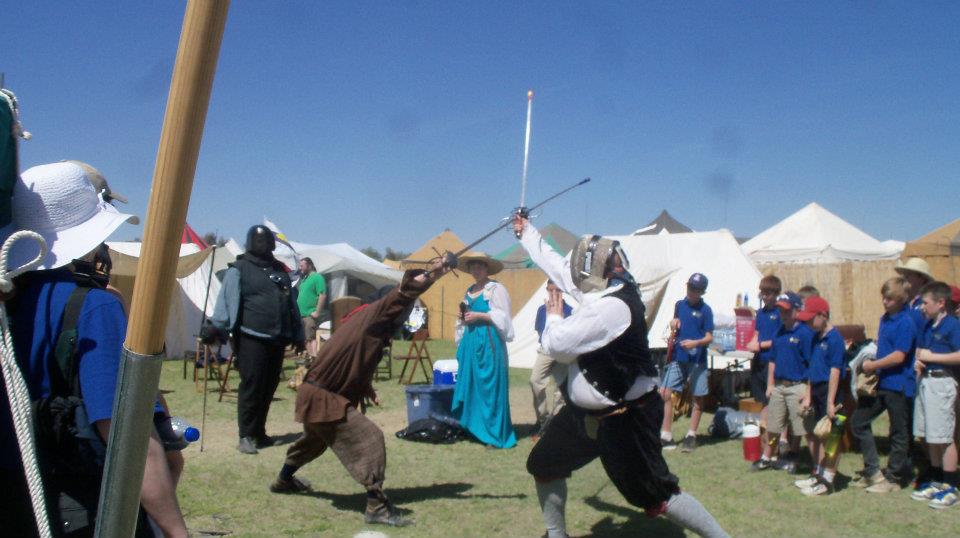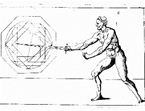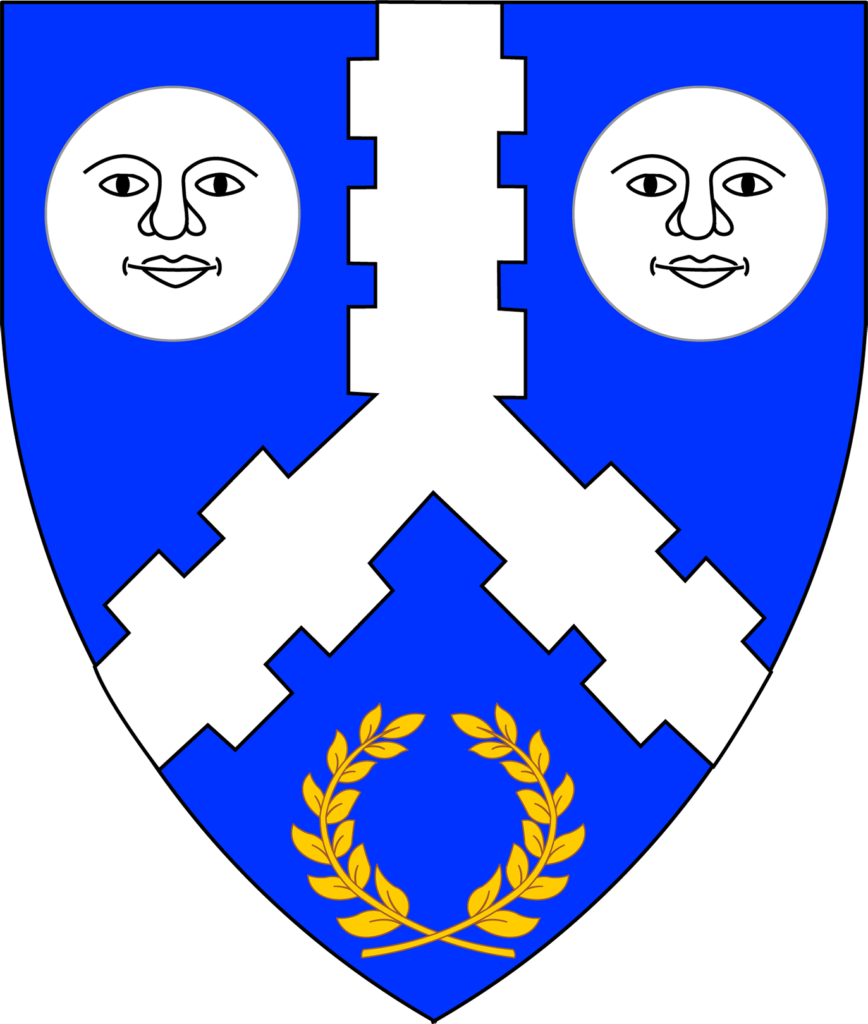The historical aspect of SCA rapier: an overview of the styles and resources
Written by Doña Perin de la Serena, DWS and Don Wyllym McLeod, DWS (Sara and Bill Lewis) with gratitude to Maestra Sancha Galindo for editing
One of the great aspects of the SCA and other recreation groups is that many people are happy to teach each other what they know. In SCA rapier fighting, you will often see taught a simplified tradition that blends together styles from multiple times and places. But, one of the things that is often lost in the process is where the styles came from in the first place. It can be very helpful to go back to the original sources for insight and inspiration. Treatises will often provide easily-overlooked details about the best technique to help you improve. Additionally, treatises add flair and style to your fighting that isn’t available unless you study a style from the fundamentals up. Finally, they contain instructions for how to counter most types of attacks and win fights. In short, treatises contain the knowledge you need to become a better historical fighter. And now there are many sources for translations of treatises that are easily available.

What is a treatise?
Treatises were written by period masters for their patrons and were also used to advertise their schools where they trained students. Sometimes, treatises were published as smaller books which were later collected into a single volume. Most treatises contain both written descriptions and illustrations of the techniques. We often see instructions for guards (how to stand and hold the sword) and plays (the series of actions for delivering a successful attack, defense, or counter attack based on different situations). Treatises may additionally cover concepts like tempo and measure and how to move. These concepts are often presented as how to counter the fighting style of their predecessors/contemporaries. Therefore, they assume that the reader had some knowledge about how to fight with a rapier, and were trying to present/sell their ideas as the superior method.
As these treatises were published in foreign and archaic language, we rely on people with historical fighting experience to translate the material and help interpret the text. A good interpretation will convey information that would be assumed in period, but unknown to the modern reader. Additionally, the author will use their own experience to explain what is meant by text that doesn’t come across with a strict transliteration. A good interpretation of a treatise for a style you wish to use is well worth the investment.
What are the different styles?
There are many different methods to classify sword fighting of the Renaissance. This subject defies easy classification due to the large time frame, rapid cultural development, and greater exchange of ideas across national boundaries. The “styles” of fencing, as with any science, adapted and changed to the times and technology. Some scholars prefer to group styles by the type of blade used (single-edge sharp, both edge sharp, only the tip sharp, curved, etc.). Others group by influence or founding master (Paduan, Destreza, Dardi, etc). And still others by the context of use (infantry, cavalry, peasant, civilian, courtier, formal dueling, etc.)
For this article, we have grouped the styles using a commonly accepted classification of nationality. The differences in these styles stemmed from national pride, the effect of a notable master in that area, the differences in blade manufacturing, the reasons they were fighting with a single sword, and the availability of publishing/patronage. By no means is this a comprehensive system, as we have limited the chart to styles that have multiple extant manuscripts with modern translations.
This criteria allows us to classify the styles into English, German, Central Italian, Northern Italian, and Spanish. Each of these styles will have visual differences in how the fencer holds the sword, positions the body, approaches to the opponent, and their favored methods of attack.
| School | English (Company of Masters) | German | Central/Early Italian | Northern/Late Italian | Spanish (Destreza) |
|
Masters (publ. date)
|
di Grassi (1570) | Meyer (1570) | Marozzo (1536) | Giganti (1606) | de Corranza (1582) |
| Saviolo (1595) | Mair | Viggiani (1551) | Fabris (1606) | Naváez (1600) | |
| Silver (1599) | Schoeffer von Dietz (1620) | Agrippa (1553) | Capo Ferro (1610) | Tibault (1630) | |
| Dall’Agocchie (1572) | Alfieri (1632) | ||||
| Primary weapon | medium length heavy rapier (hilt to navel) | 2-handed long rapier(ish) or short and heavy cutting blade | short to medium length cutting blade | medium to long length, light to medium weight rapier | short length, light weight rapier |
| Characteristics | Upright, heavy cutting stance. Simplified adoption of other schools. Emphasis on simplicity, disarms, and strong strikes. | Dynamic stance with cutting, level changes, and cross-steps. Attacks as part of defense, militaristic tradition, wrestling. | Upright stance that prefers cuts, offline attacks, and body voids. Complex systems that were derived from military traditions. | Defensive stance favoring thrusts, small blade movement, linear footwork, and counter attacks. | High guards/point with extended circular movements and attacks to get mechanical advantage from height and leverage. |
| Influence | local tradition, Spanish+Italian | Talhaufer, Lichtenauer, Fabris | Dardi | Earlier Italian (esp Agrippa), Di Grassi | Agrippa |
|
Resources
|
stoccata.org (English shortsword) | Jeffrey Forgeng translation | Tom Leoni’s books | guywindsor.net | destreza.us |
| Online books by Silver | Robert Rutherfoord Youtube channel | Jhrek W. Swanger books | Guy Windsor Vimeo channel | blackbirdsandblades. blogspot.com (extensive list of resources) |
|
| thearma.org (essay on Saviolo) | Blood and Iron Youtube channel (drills) | marozzo.com (Ilkka Hartkainen) | Tom Leoni’s books | ||
| Academie Duello Youtube |
English
German
Early Italian
Late Italian
Spanish
Common Initial Guard





How do you apply what you read in a treatise to your fighting?
First, acknowledge that it will take some work, but it is fun and it will improve your technique. Just reading the book isn’t going to automatically change your fighting; the trick is to practice what is shown to create muscle memory.
- If you have access to teachers who study a system you are interested in, you are in luck! Good opportunities may involve travel or crossover to other combat/recreation groups, and that is ok. If you have someone you want to learn from, ask them. Don’t assume that every sparring or practice is going to involve focused instruction. Be specific (and appreciative) in your request.
- If you want to learn more about a specific master/style, buy a copy of the treatise and read it. It is helpful to do this with a friend as you can point out interesting things you’ve learned to each other and try out the plays. Work in shorter sessions to improve retention; it is easier to focus on and learn one concept or action at a time.
- Watch videos of how to drill a play to help you make the connection between a static image and a sequence of actions. There are some excellent resources in the table to help you get started.
- Make time to drill (30 minutes a week is a good start) and do it consistently. Start with simple drills of a single action. Strive for perfection in blade placement, body mechanics and footwork instead of speed. Work with a partner to give each other feedback to make sure the technique is correct. Repeat it until it either feels ‘right’ a few times in a row or you get tired. A note for when you are working with a partner and you are the ‘bad guy’, don’t try to win the drill. Your job isn’t to try to counter the play, but to provide the sequence of events that makes the play possible. Commit to the action required from you and provide a reasonable amount of pressure and challenge to help your partner get it right.
How do I get started?
A good place to start is https://wiktenauer.com/ This is a free, searchable resource for information about period masters and treatises. Original pages or translations may be uploaded or provided in the links/references. Follow the links to learn about the treatise material, related masters, and the history. Want a bit more context? https://en.wikipedia.org/wiki/Rapier
Our recommendation for a good “starter” translation for rapier that applies well in SCA and other recreation groups is Giganti’s The School, or Salle (translated by Tom Leoni) https://www.freelanceacademypress.com/venetianrapier.aspx Giganti believed in a fairly intuitive body mechanics and takes a reductionist approach with a relatively small number of plays to cover a large range of situations.
If your interest is longsword, my recommendation is Fiore’s Flower of Battle (translation by Colin Hatcher) https://www.amazon.com/Flower-Battle-MS-Ludwig-XV13/dp/0984771689/ref=cm_cr_arp_d_product_top?ie=UTF8 Fiore presented a complete system from wrestling, to dagger, to longsword.
There are some online schools that have created excellent materials for interpreting plays into drills. These include https://www.swordschool.com from Guy Windsor, which covers a wide variety of source material and general martial training topics. In particular, there are short video clips showing individual plates from Capo Ferro that can help bring these treatises to life. https://www.academieduello.com/ is another good online school. The advantage of online schools is high-quality, easily applicable information. The downside is that only a small fraction of what they offer is free, so you will get the most out of it if you are willing to buy the content.
Find a group and go to their practice! SCA: https://www.sca.org/geography/findsca.html
—————————————————————————————–
